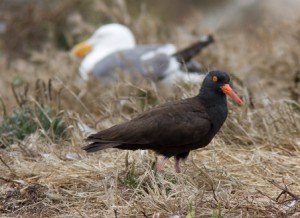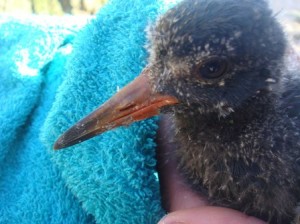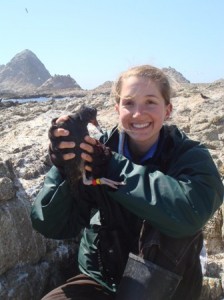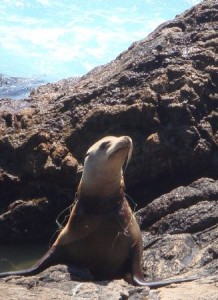So, there is one species of bird breeding on the island that I’ve hardly said anything about–the Black Oystercatchers. This is partly because their breeding population here is small, partly because not much work is done with them, and partly because they are hard to get to. Black Oystercatchers nest right along the shore, and it’s hard for us to handle them without disturbing all of the seals and sealions that haul out along the rocky shoreline here.
There is, however, monitoring of the black oystercatchers that occurs–this year, it’s Hannah’s project. She watches them through a scope, noting how their chicks are growing and where their nests are. And, a couple of times in a breeding season, we crawl, on our hands and knees, out to their nest sites to band their chicks. Today, since I had a light workday, I got to go along.
Black Oystercatchers (BLOYs) are really cool birds. They have long orange bills, bright yellow/orange eyes, and weird stick-like, light-colored legs. They also make a really high pitched shrieking sound, almost a squeak, and their chicks are very cute.
BLOY chicks are banded when they appear to be almost fully feathered, meaning their flight feathers are almost all the way in. This way, they’re big enough to band, but not so developed that they’ll fly away when we try to catch them. As you can see here, at this stage, the chicks are starting to develop their orange coloration on the bill, but still have some downy patches around their body and face. They’re very calm as far as chicks go–they don’t twitch or try to break free, and so they’re not too difficult to band.
Banding the BLOY chicks was a ton of fun, and took most of the afternoon. We only ended up banding four (that’s actually a pretty high number, considering how few there are out here), but each banding took a really long time. This is because to band them, we had to go to places on the island that people don’t usually go during Seabird Season. I got to visit some places down by the water on the marine terrace that i’ve only seen from the lighthouse (It’s amazing to think about how many places on the island, despite its very small size, I will never see). As I mentioned earlier, we also had to get to these sites by literally crawling on our hands and knees, so as not to disturb the pinniped populations.
Banding the BLOY chicks managed to get me closer to the sea lions than I have been since I got here. The elephant seals I work with are abnormally calm around humans, but california sea lions, stellar’s sea lions, and harbor seals (outside of places like Pier 49) are actually really skittish creatures.
I got close enough to some sea lions to notice that this one, unfortunately, is a “ringneck,” meaning he’s gotten tangled in some sort of human-created line. We’ll note this in the journal tonight, but unfortunately, there’s not really anything we can do about it, and it’s very sad.
Other than banding BLOY chicks, I had a relaxed day, so I did laundry (for the second time since I got here), mended mistnets, and spend some time in the Sea Lion Cove blind watching Gray Whales.
Tonight, Meghan is going to show us pictures from her doctoral work in Russia, where she worked with Siberian Tigers. Should be really neat!
Best,
Eleanor




